Wolfram Wittig is one of a kind. If you’ve still got a stereotype of the stern, hard German riding master in your skull, then you haven’t met Wolfram. Despite having the responsibility of looking after some of Germany’s very top horses and riders – including Isabell Werth and her team – Wolfram seems to find life one endless source of amusement, and the joke and the laugh are never far away, but he is also very much a thinker… a conversation with Wolfram is a bit like a roller-coaster ride, whooshing its way from training to breeding to dressage ‘politics’ and back again, at breath-taking speed… as you will discover before long.
Wolfram and his wife, Brigitte, operate a state-of-the-art training centre in the heart of horse-loving Westfalia, where they train a team of top riders, and produce a seemingly endless supply of wonderful horses, bred through their own breeding program – headed up by resident Grand Prix stallion, Breitling.
The day we arrived, there was a bonus in the form of one of Germany’s most talented young dressage riders, Kyra Wildfering, who was working two very talented stallions, Revan and Rubinero, both owned by Gedula Vorwerk whose famous stud, has alas, been purchased by Austrian multi-billionaire, Sissy Max-Theurer, to use as a brood mare farm…
Kyra and Rubinero
Rubinero is very much a Vorwerk product. He is by Rubinstein, perhaps the most famous stallion discovered by Gedula, and out of a mare by Ex Libris, and in turn out of a mare carrying the blood of the two stallions that made her father, Georg Vorwerk famous, Furioso II and Inschallah.
The stallion starts out showing his wonderfully clear walk, before Kyra seamlessly slides into the collected work, piaffe and passage. Sure, the movements are not perfect every time, but the rider keeps quietly asking, and every now and then, it comes, and then it is wow! It is the same in the canter work, collect, collect, collect, the stallion practically cantering on the spot before trying some half pirouettes, coming out and holding the counter canter through the corner. At the end of the working session, I remark to Wolfram how boring it is, that good trainers just keep doing the same old things over and over…
“If a horse is four years of age or fourteen, it does not matter, every day you have to train the basic work. It is the most important thing. Once you have the basic work, then you can improve with the exercises later on. If the basic work is not well done, then you will have problems with each new exercise.”
It was interesting in the exercise with the half pirouette, holding the counter canter through the two corners, when the easy thing would have been to do a flying change – is that important, to keep control of the side of the horse?
“If we train the half pirouette in that way, then we do four or five to each side, and not every time changing to the other lead. We have to make sure that this pirouette was okay, and then you start the next exercise. Because if the first to the left is not okay, and then you do the next to the right, for the horse it is quite difficult. First make sure that on the left it is really good, and then do it to the right, and when that is good, you can do one left, one right, then that is it – just to test.”
You don’t do anything special with the horse’s frame, it is all in a very natural position…
“That’s how it should be. I like to work the horses with a normal snaffle bit in a normal frame. The horse has to carry the weight, not the rider. We are not here to carry the neck or to carry the head.”
With a very professional rider like Kyra, then it is easy?
“Yeah, it is a nice job, the rider is very talented, and very willing, then it works together, we are very definitely not the enemy of the horse.”
It is not a long working session?
“No, it is probably 35, 40 minutes, that is the maximum. Then they walk down for ten minutes. They warm up for ten, fifteen minutes, then we do our job, 20 – 25 minutes, then again make everything loose, so about 45 minutes in maximum.”
Back to the arena comes Kyra with another of Mrs Vorwerk’s stallions, this time Revan, by the Rubinstein son, Relevant, and one of Wolfram’s up-and-coming stars, the mare, Biagiotti W (by Brietling out one of Wolfram’s foundation mares, Diego) with Brigitte Wittig. Wolfram is rightly proud of yet another of his home bred stars:
Brigitte and Biagotti
“Biagiotti – she is a lady, really a lady she would prefer to go on the catwalk. She is now nine years of age, and look she is working with a breeding stallion, close to the mare, and nothing happens. Stallions should be like this, under saddle they have to know that they are under orders, everything is clear. Biagiotti will be the next Grand Prix horse for Brigitte.”
It doesn’t affect the stallions – breeding mares as well as competing?
“For some stallions, it is difficult, it depends on their character, but if you are a breeder, a responsible breeder, you like to have horses with a good character because nobody likes to fight against the horses. If the breeding is better and better, it is easier for us. In breeding we should not forget about the character, we only think about movement, movement, movement, and if you cannot manage the movement and the character, then it will go worse and worse. Then we make new rules for the prize giving for these horses… it is the character that is wrong, or the training, but why is it not possible with the best ridden horses for them to come to a normal prize giving ceremony?”
We noticed when we visited you the first time, that when you bring your stallions out of the stable, you can drop the rein and they stand… we go to lots of studs in Germany, and the stallions there are not so well-behaved as your stallions…
“I have a very good contact to my stallions. If I go into the stable and whistle, they start to paw with the fore-leg, I’ve taught them that, they are okay with me. (As we walked past the horse wash, Wolfram whistled, and the young stallion in the wash pawed on cue). I think what is important with these horses is that I am the breeder, I know them from the first phase of their life – then you have really close contact.”
“This is Revan… like Rubinero, he is out of the breeding career because Vorwerk Stud is sold to Mrs Max-Theurer, and Mrs Vorwerk owns these horses and Kyra is competing them…”
Kyra and Revan
But that is the sad thing about the present, there are good stallions who get no mares, and there are bad and un-tried stallions, that get hundreds of mares, and the good breeders, like Mrs Vorwerk, they give up…
“It is public relations, and in the future we will get the penalty for this, we get the result in the future. But you cannot stop it…”
Because the local farmers no longer breed to local stallions?
“Yes, and every time you have less and less farmers. Some farms get bigger and bigger, and the others retire, then you have less mares in less hands. And there are less people with experience with horses, they need the old knowledge – but it is not interesting, you cannot make money with that. Breeding is now, money makes the world go round, and the stallion business shows us that it is just the money, it is not really a breeding system.”
But do you think people are going to realize this and say, we’ve got to get back to stallions with more rideability, better temperament…
“It is difficult to turn a wheel back. Now it is a fact of life, and you have to accept it. If we only used the old and very successful stallions, in ten years we get the same question – there is no development – because you are only using the old stallions.”
But now we only use the new stallions…
“Now we only use the new stallions, the licensing winners, and we have no experience of what their children will be like. Then in four or five years, you see the result! Some of them have covered more than two thousand mares, and you have all these horses, then it is too late. But the responsibility is with the breeder, the breeder selects the stallion, he owns the mare and it is his decision, and if he wants to sell the foal, then breed to last year’s licensing winner!”
Breitling – Wolfram drops the reins, and he stands…
But you get a stallion like your Breitling and he has bred many FEI horses, but he is not fashionable…
“Not everybody breeds for the sport, they are looking for sales. It takes a long long time to get your money back when you breed for the sport – better to breed for the foal auction. If you take all the responsibility for the horse, for its health, its management, its training, then that costs a lot of money, and you have to really have knowledge when you select for this – because it’s your money you’re spending. You take responsibility for the horse, and later you see, was it a good selection or was it bad? If I sell as a foal or as a two year old, I know nothing about the horse. But if I make my selection, and say, okay we try and train, that is something else.”
But you have been very successful doing this…
“I have a lot of luck maybe, I don’t know. But I say, this is my selection, and we try and train them.”
It was good to see Revan again. We saw him worked many times at Vorwerk’s, as a young horse when Lisa Wilcox was the rider, and he has grown into such a handsome horse. Once again, the work is ever so normal, no head on the knees, nothing special, just loosening up the horse, breezing along in the canter, the horse’s mouth nice and wet, the bit, a simple snaffle, the horse’s eye calm and happy…
And gradually it all comes together, the cadence starts to shine through, now the stallion’s neck is flowing so beautifully out of his shoulder, the hind legs perfectly engaged, and now there are a few steps of wonderful lengthened trot on the diagonal, not one tiny bit faster, the horse still so soft and supple…
So what were you doing with Kyra and Revan?
“Some basic work, and then some exercises, the horse is now competing Prix St Georges and Inter 1…”
Do you have a plan of what you are going to work on?
“Yes, I have a plan, my horses show me the plan – what is possible and what is not possible. It depends always on the horses. You have to be flexible, if they are in a bad mood, and you ask for the same things like you did yesterday, you will have trouble with the horse.”
It is sad for journalists because when you see good training, there are no exciting tricks… good training is boring…
“Normally dressage is boring, but sometimes, like at the European championship, there is a horse like Totilas, which does a really good job, the crowd is happy because this is totally different to the work every day – if it looks so nice, and so many people are happy, then it must be right.”
I have never been a big fan of the Dutch system but the two horses that starred at Windsor, Totilas and Parzival, they didn’t look scared or angry…
“Absolutely, and they could come to the prize giving. I only saw it on the television but if we have new combinations, and more people focused on our sport, it is good for our sport. If they like that picture, we have to accept it but as riders and trainers, we should not work to make this picture more and more expressive, because this is not possible. So we have, in my opinion, to make a small step back to really relaxed horses, really loose – the happy athlete. For me this is a very important step.”
So you think we need to come back a little further to a more natural way of showing?
“Yes, I think so.”
And this is the responsibility of the judges?
“The judges give the marks, the riders do the job… it’s not showumping, so if they like it, we have to accept it.”
Do you think the judges could take a more positive role in looking for more relaxed work?
“It is not only more relaxed or natural work because it would be very easy to focus just on one thing, but Windsor was really for dressage, a good show. It was like a new step and then we have to wait: what is going on in the future?”
Will the German team be able to re-organize itself in time for Lexington?
“I’m pretty lucky not to be the German coach… Isabell is back in the saddle, so it looks definitely better for us. But honestly, if you only focused on Germany on what rider will deliver the medals, this is not a good development for us. At Windsor we were 10% away from the medals! That’s a big gap.”
So what can be done?
“First we have to discuss, why that happened. Second, we have to definitely work harder, and then I think we can come back, but it is really hard, we have to accept that. I think we cannot do it in time for the WEG, I don’t think it is possible.”
Do the Germans need to give more chances to the up-and-coming riders?
“Definitely, now we have the new class, the young horse Grand Prix, from the age of eight to ten. So we are calling the ten-year-old Grand Prix horse, a young horse. The European Champion is nine years of age… we have to think why.”
Do you think it is because they are breeding better horses in Holland? Are they training their riders better? Or are they lucky?
“Definitely they are working together. The horse breeding is definitely not the problem – the German horses are 100% good enough. All of the Dutch horses have German breeding – two of them were Hanoverians, the others had German blood. Our horses are good enough, we need really good training, and to also be more critical, but if you are criticizing something in Germany, they think you like to fight against the system, but if the system shows us that we are 10% behind the medals, we have to ask, is this the right system?”
Revan has been sharing the arena with one of the tallest ‘babies’ you’ve ever seen, the three year old filly by Breitling out of a Fabriano mare, is really spooky and finding it hard to find her balance, but the rider, trainee, Claudia Feldmann, keeps cool, just helping her find her way…
With this very young big green mare, it was nice the girl just rides her and it doesn’t matter if she gets a bit frightened here or there, she just keeps quietly riding…
“There are some frightening things in there, some shadows, but nothing happens, we show her first in walk if it doesn’t work in trot, then it works in trot and canter.”
It’s harder for a tall young horse to find the balance?
“Yeah, she grows and grows and grows, and it makes it more difficult for this horse to find the rhythm, that is normal. Just quietly ride, no stress, nothing. The important age is the end of four, start of five, then it starts to be important for the horses – here it is just a game.”
With Revan?
“We are preparing for the show in Oldenburg, Kyra is competing him at Prix St Georges, you see two mares and the stallion, all in the arena together and it works.”
And his mouth was so nice a wet just with a snaffle bit, and not even a whip?
“It was not necessary, he is a calm boy, very friendly.”
Would you prefer to work them without a whip?
“The whip is a normal aid for the horse, and we should not start to fight against the whip, better we should start to fight against bad riding, that’s what we should focus on, not whip or not. If I see scared horses in the prize giving, they are all without the whip, so the whip is not the problem…”
“So many dressage riders are asking for hotter horses, okay we can focus on that and breed in that direction, but if the horses don’t reach the top sport level, and they are still hot, what are you doing with these horses? Then they are dangerous to the riders if they are not good enough… We must have really talented horses with good movement, good character for the top level, and if they are only hot with no movement – what are they going to do with them?”
But people say this often, that the horse for the Grand Prix must be a bit crazy and not a horse the normal rider can ride, do you agree with this?
“No. A good horse is still a good horse. A very good example is Satchmo. Satchmo is never scared. He goes in all prize-givings, every time, beautiful walk, he was never scared. You ask Isabell, if she would select one of her horses to go out on the field, she would take Satchmo.”
So you don’t think there are two sorts of horses we breed for – the horse for the housewife to ride in the fields and the other, the horse for Isabell to win a gold medal…
“The horse must be useful for everybody, and then depending on the quality of the movements, we can decide what to do with the horse.”
They don’t have to be crazy to go Grand Prix?
“I don’t think so. If you want to reach a high level, you don’t ask for crazy, because if you can’t control it, it is like a bomb. The Grand Prix horse should be good in the mind, and we should be focused on breeding that, otherwise we are taking the wrong direction. If riding is dangerous, we will lose our acceptance in the future. If everyone says to ride we must have crazy horses, and everyone is saying, be careful, please be careful, it is not acceptable. If you cover a mare, you don’t know what the result will be – you can have your plans, but if they want only hot horses, then they can ride Thoroughbreds – they are hot enough – but no-one is asking for that. They say ‘oh no, the movements are not good enough!’ – so we have to find the way in the middle, but the horse must be useful for everybody. Then it depends on the training, which classes they are reaching, but it is not possible to breed exactly a Grand Prix horse, definitely not possible. If you ask ten riders to describe a Grand Prix horse, you will have ten different horses. Taller, smaller, bigger, heavier, male, female… so for whom should you breed the horse? At the moment you are breeding, your client is not there!”
There have been a number of young Australians, smart enough to find their way to the Wittigs’ stables: Larissa Chadwick, Kevin McNab… and just before we turned up, Queensland’s Emma Flavell.
You have just been training another young Australian, Emma Flavell…
“Emma and her black stallion. Emma did a really really good job, it was nice for me to see. You know Australia is a long way away, and if they come here, at first you are a bit careful. I had no knowledge of Emma, but now I must say she had a very good feeling on the horse, very good seat, good balance – it was really nice to work with her.”
He is right you know, the Wittig stables – and breeding operation – are truly an amazing place. We take our leave of Wolfram and Brigitte, thanking them once again for their hospitality, and for Wolfram’s willingness to share his knowledge… and his jokes.

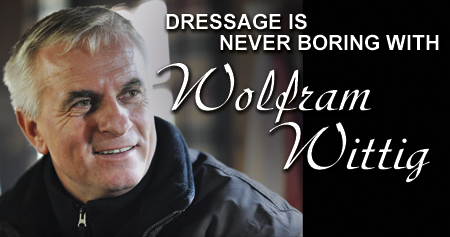
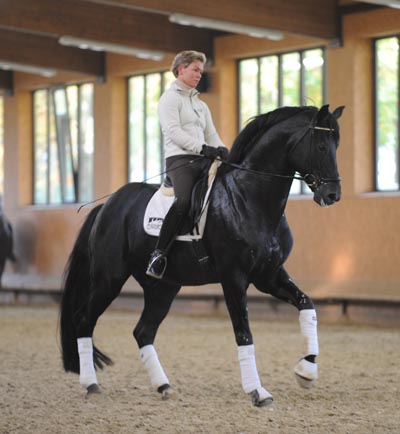
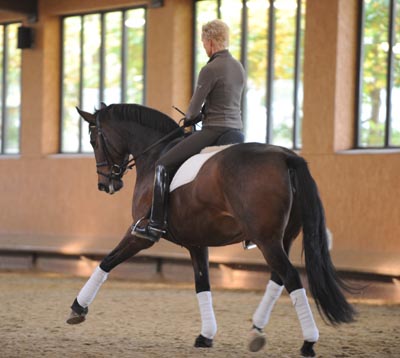
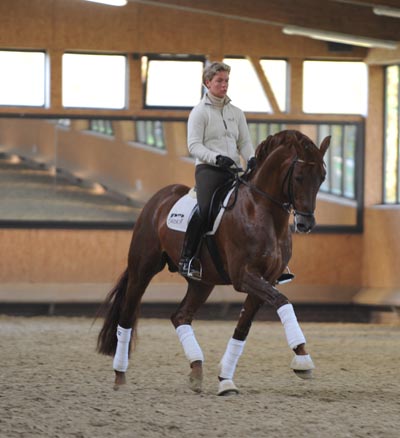
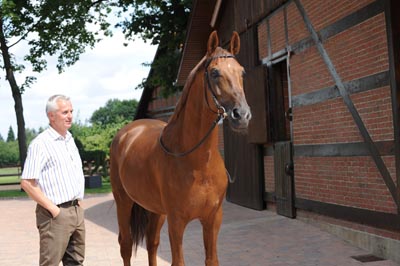
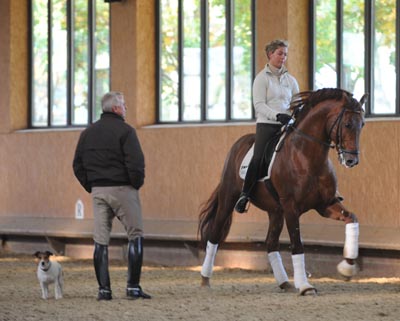
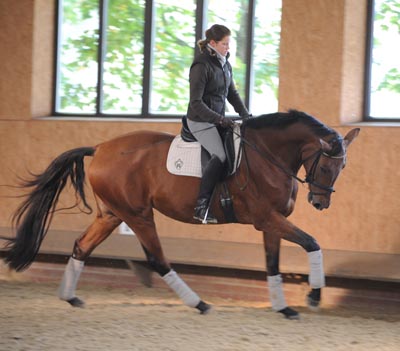
The Holsteiner verband has a practice (not sure if still in effect but I think so) that if a breeder uses a new popular stallion one year, then the following breeding MUST be to one of the older stallions.
And of course, vice versa.
Why does this not become the practice for all the verbands?
Especially as Holsteiner stamm lines are recognized everywhere as one of the great breeding treasures, world over.